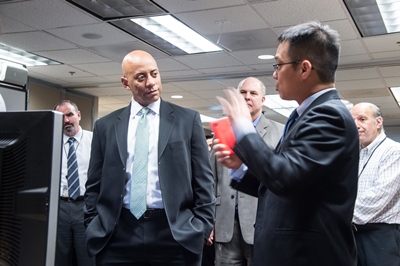 Sensors and actuators embedded in real world objects such as cameras, cell phones, drones, fixed, deployable and mobile devices and physiological and environmental monitors when connected to the Internet, form what we call today “the Internet of Things.” This platform has the potential to serve first responders by enabling them to sense the environment, collecting information, communicating and interacting with each other in real time during emergencies.
Sensors and actuators embedded in real world objects such as cameras, cell phones, drones, fixed, deployable and mobile devices and physiological and environmental monitors when connected to the Internet, form what we call today “the Internet of Things.” This platform has the potential to serve first responders by enabling them to sense the environment, collecting information, communicating and interacting with each other in real time during emergencies.
On January 13th, I had the chance to learn more about S&T First Responders Group (FRG) Internet of Things (IoT) pilot project firsthand. FRG brought together a team comprised of representatives from industry, a university and a standards development organization to demonstrate various IoT sensor technologies and how they can be integrated to provide the first responder community real-time situational awareness during critical incidents.
I learned IoT is not just about the increasing number of sensor technologies, but also about FRG’s role in advancing industry open standards to ensure these technologies are interoperable. This is imperative as it allows first responders access to the rapidly changing data provided by the IoT sensors to assist them in preparing for, responding to and recovering from a disaster.
But while instant access to information is critical for first responders, it’s equally important for industry to use open standards so their sensors can provide immediately identifiable, accessible, interoperable and useful information across all first responder teams.
That is exactly what FRG’s Information Application and Standards Division Director Jeff Booth has been working on with partners like the Integrated Justice Information Systems (IJIS) Institute, the Open Geospatial Consortium (OGC) and a team of global technology performers, for the last six months.
FRG’s IoT Phase I demonstration showed how the project has been designed to integrate and exchange data from a variety of proprietary sensor types including: Smart shirt and SmartWatch (physiological monitoring), vehicle geospatial position (location and orientation), mobile video cameras, laser rangefinder, plume model and others. The IoT sensor integration team demonstrated the use of these technologies in a real-world-type incident scenario where multiple first responder domains—fire, law enforcement and emergency medical—discovered and applied diverse commercially available sensors and platforms to provide situational awareness.
I was impressed with the ‘state of the practical’ where these various industry sensors can be integrated today using open standards that remove the stovepipe limitations of one-off technologies.
I am looking forward to the next phase of the IoT project which will focus on integrating the sensor technologies with a communication ‘hub’ as part of the Next Generation First Responder Apex Program.
Dr. Reginald Brothers
Under Secretary for Science and Technology
